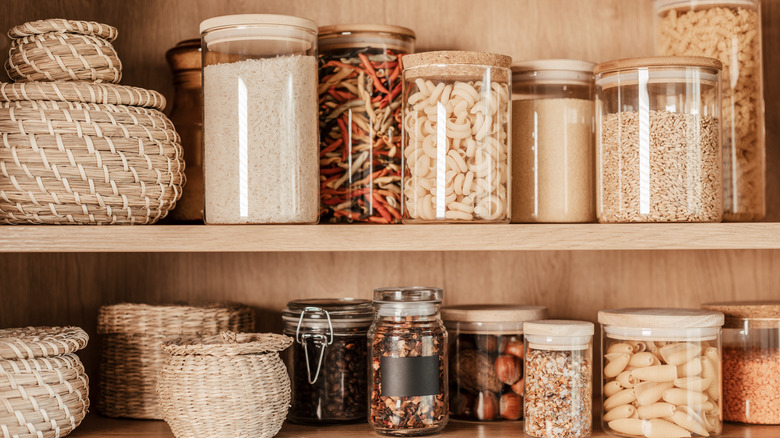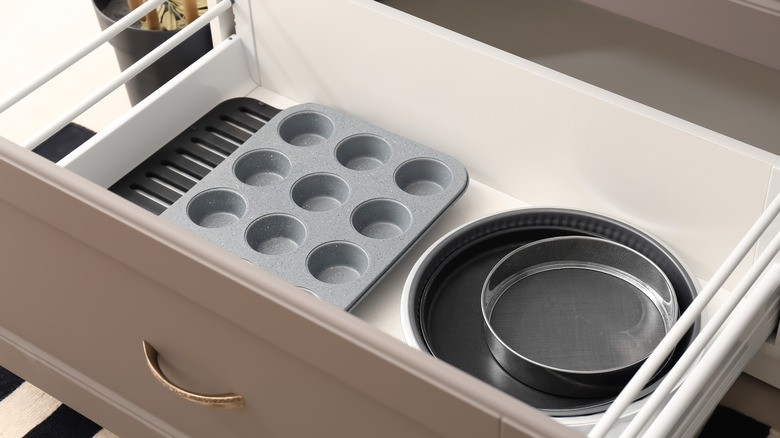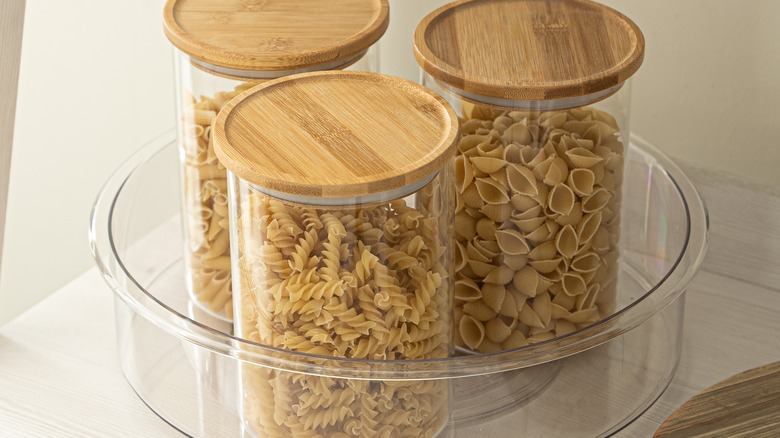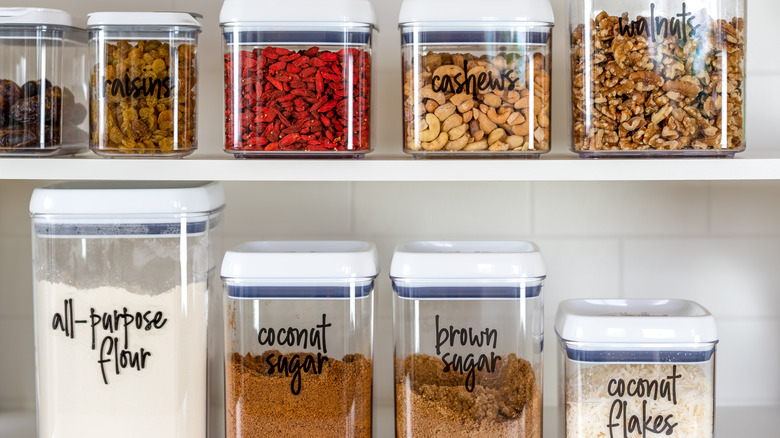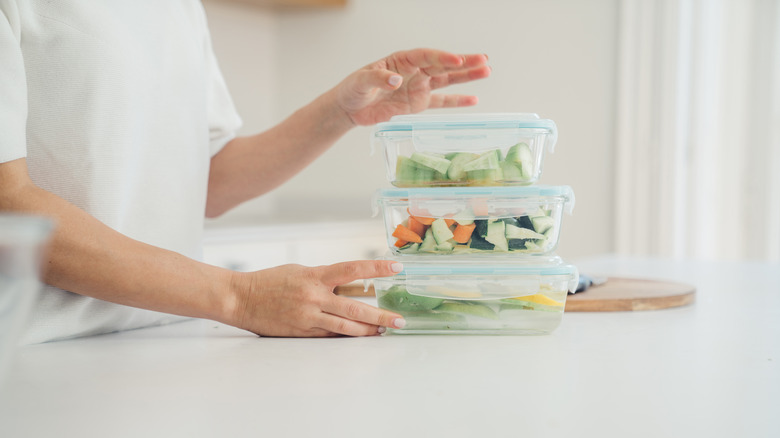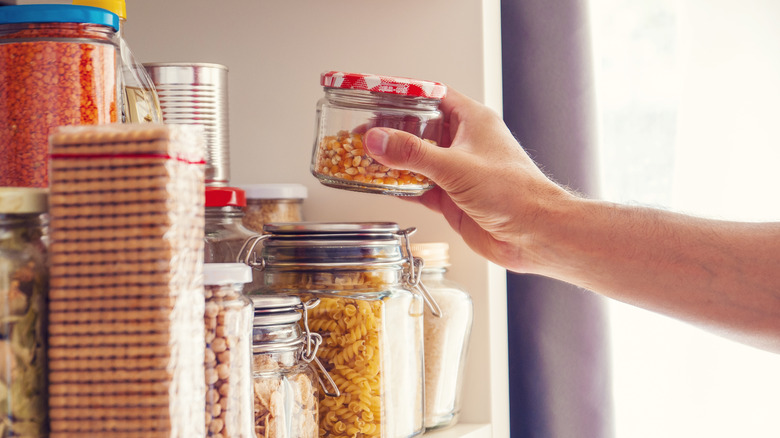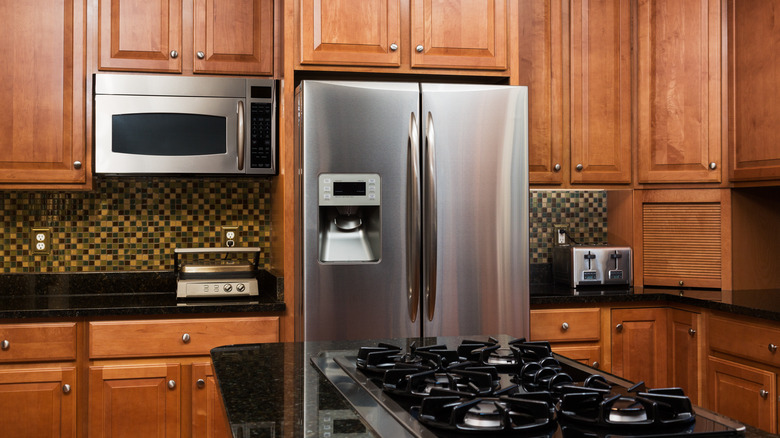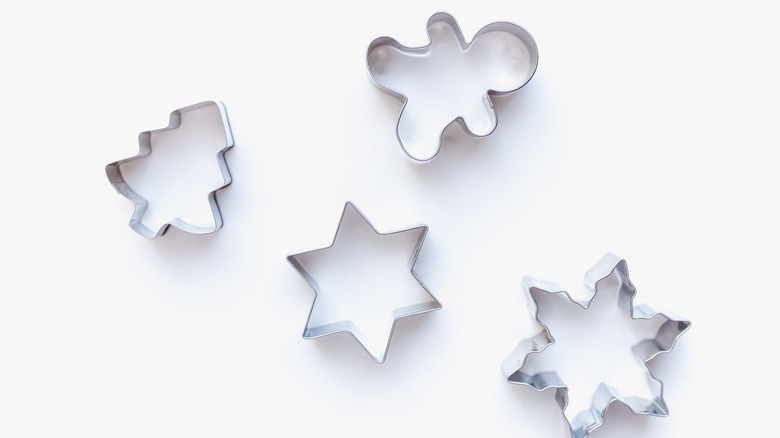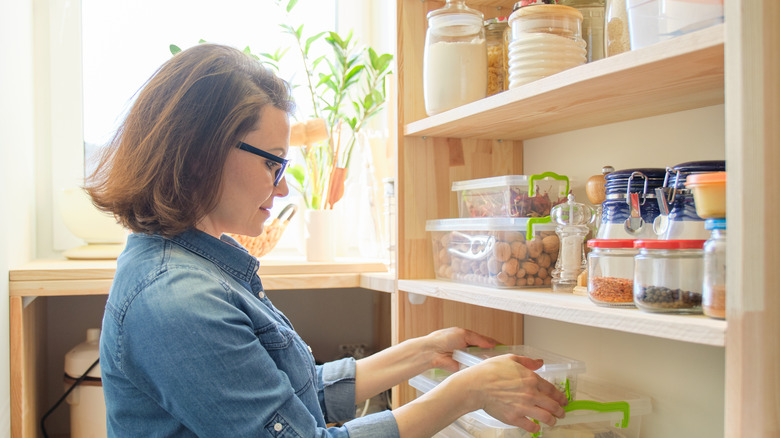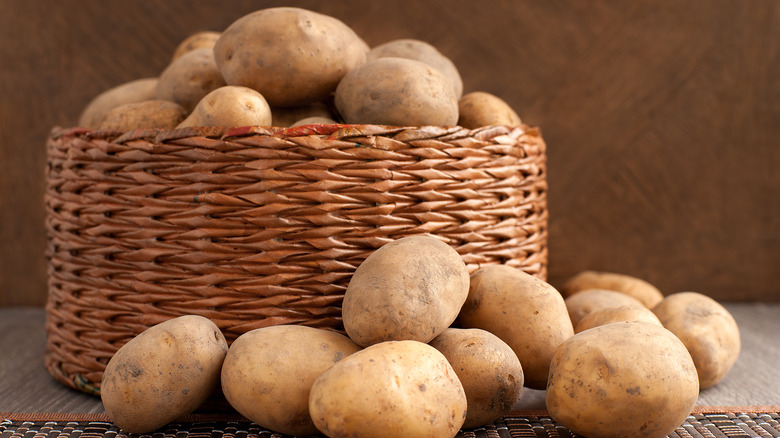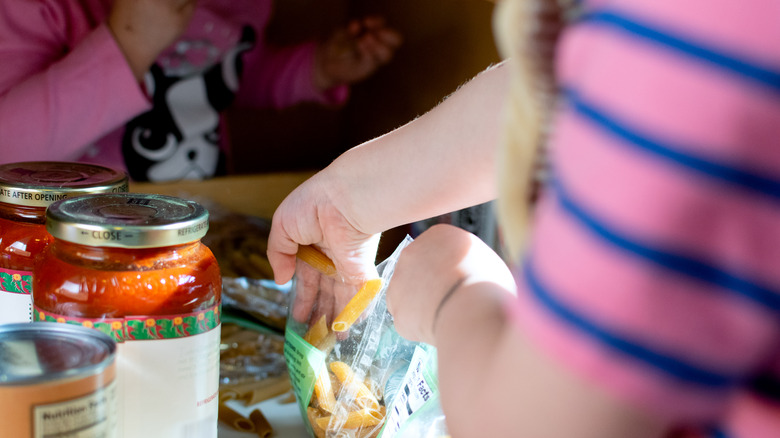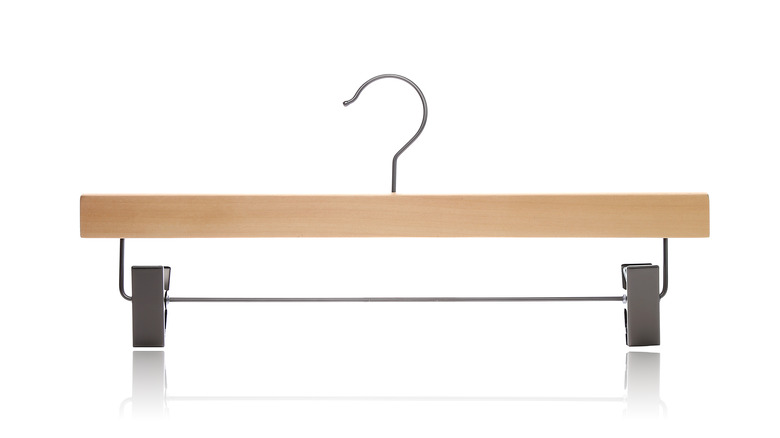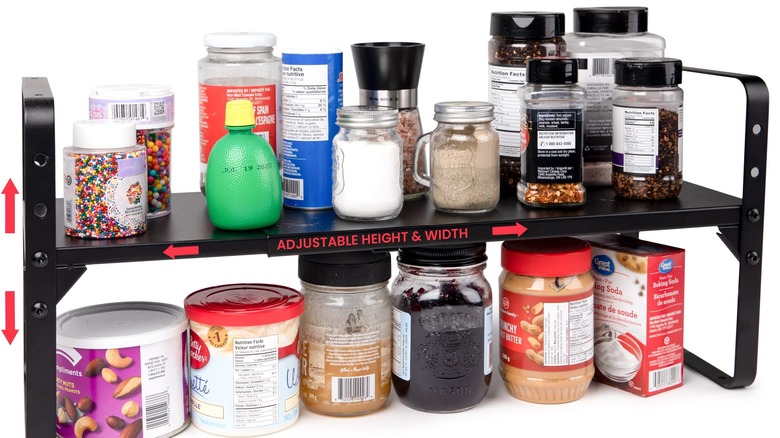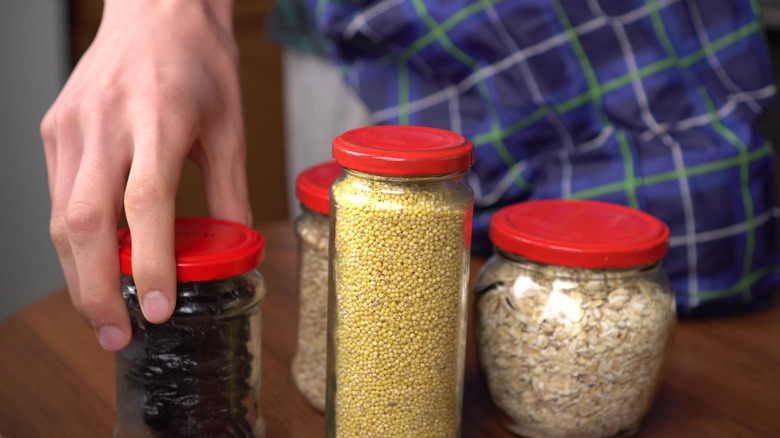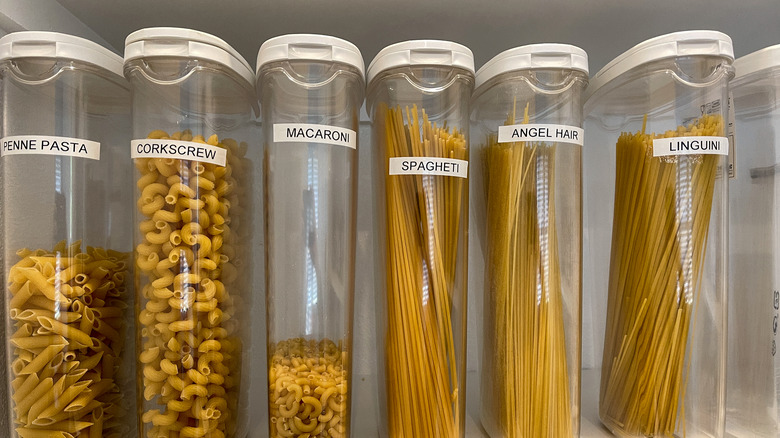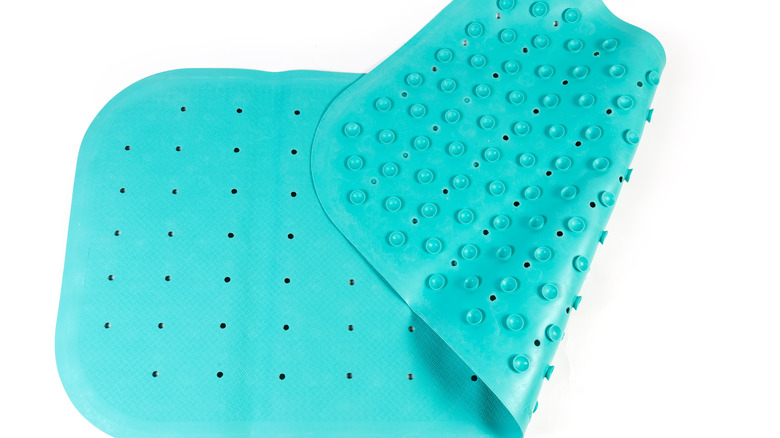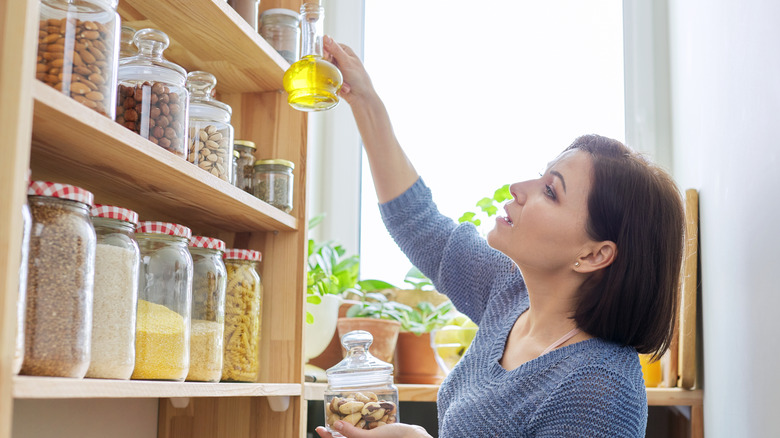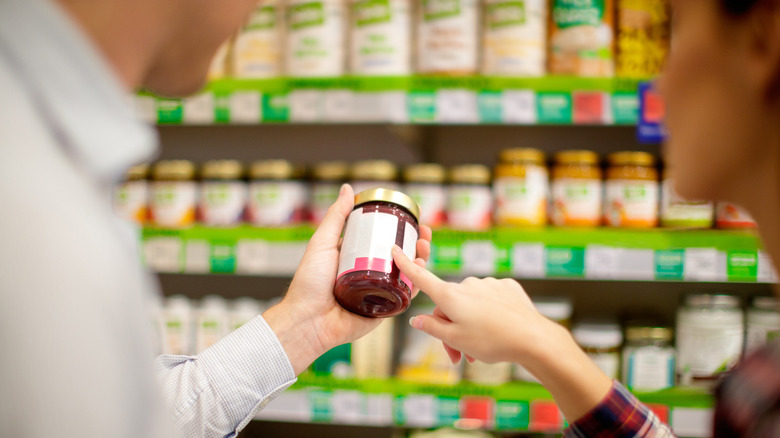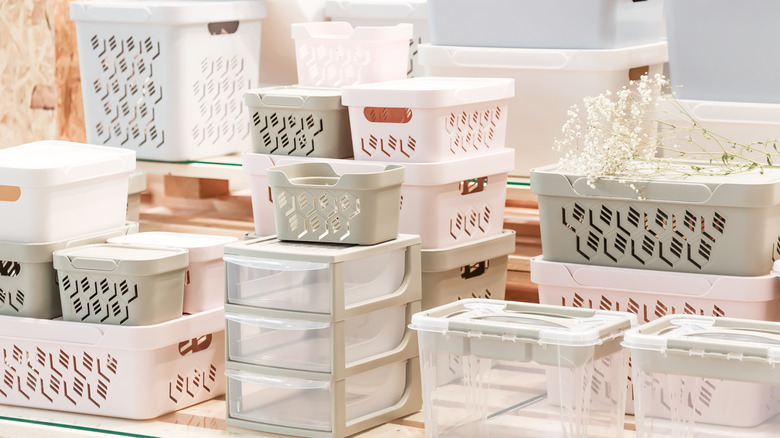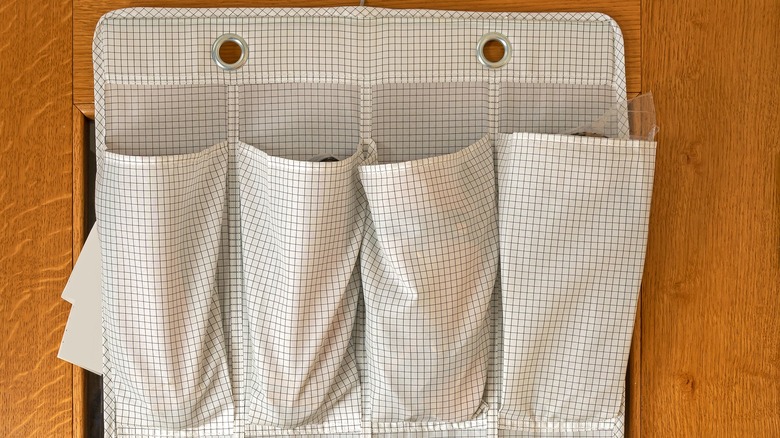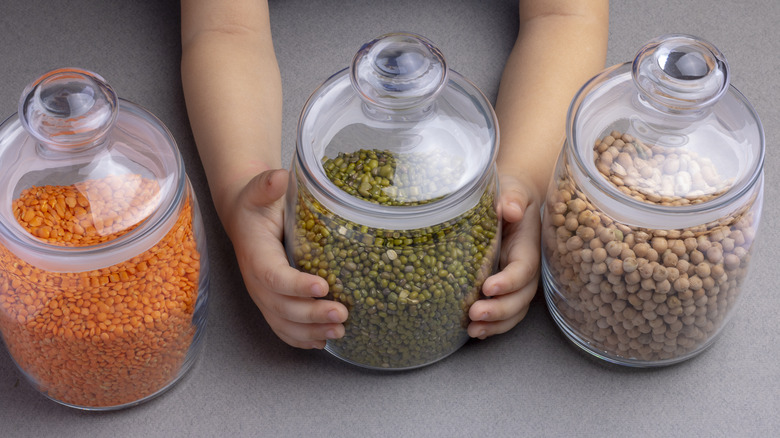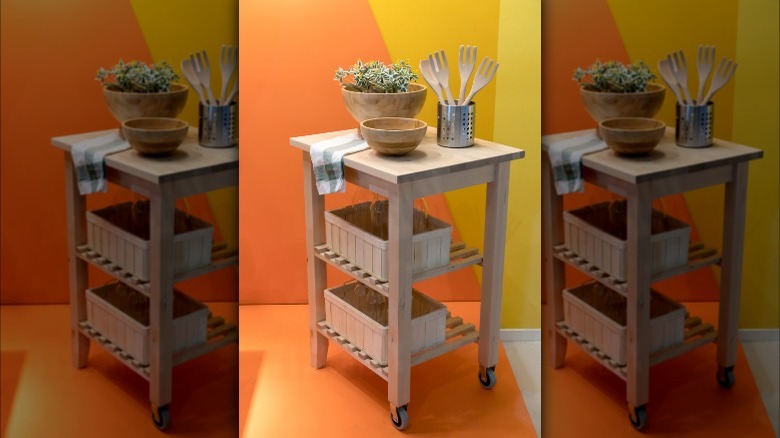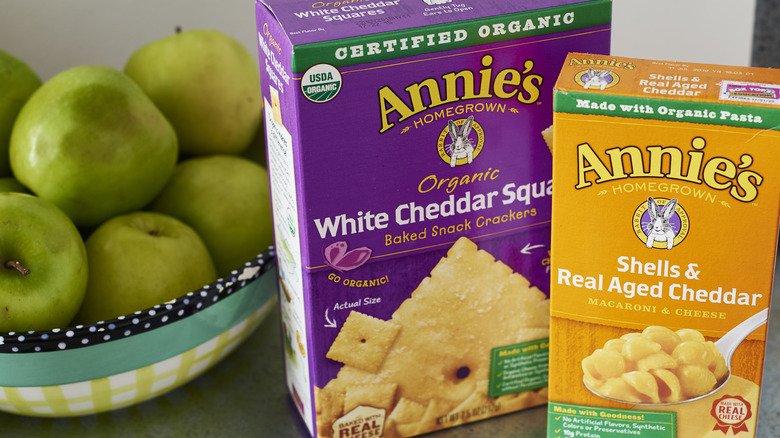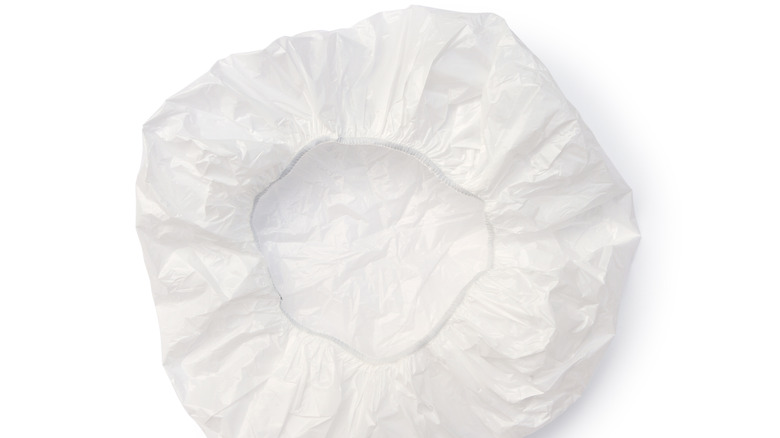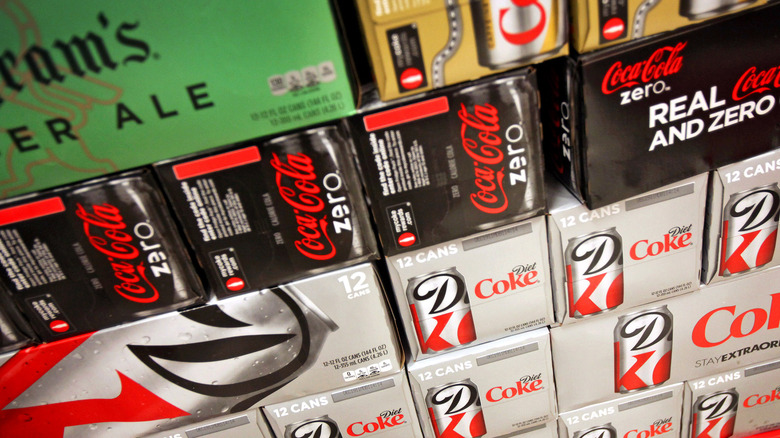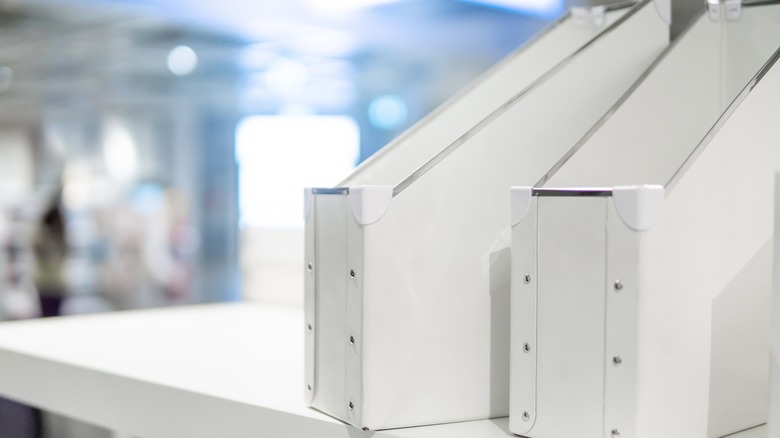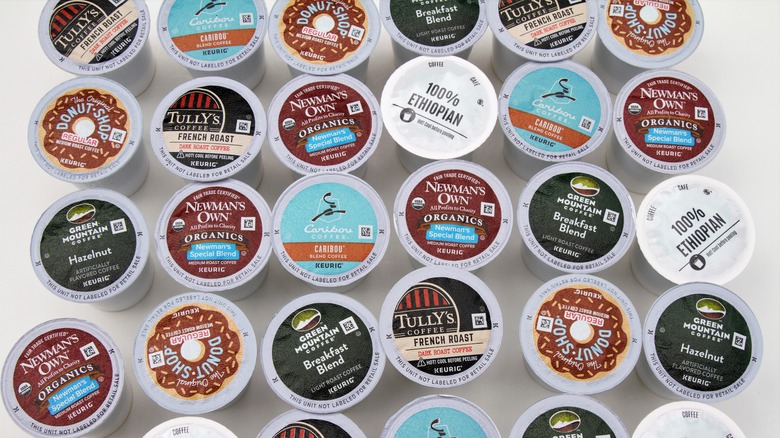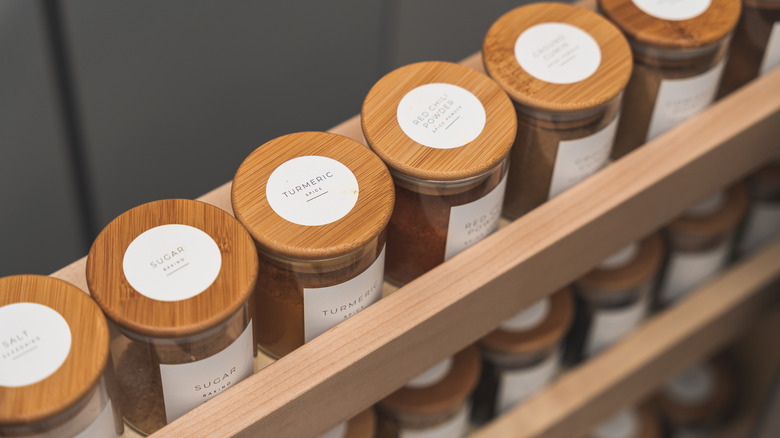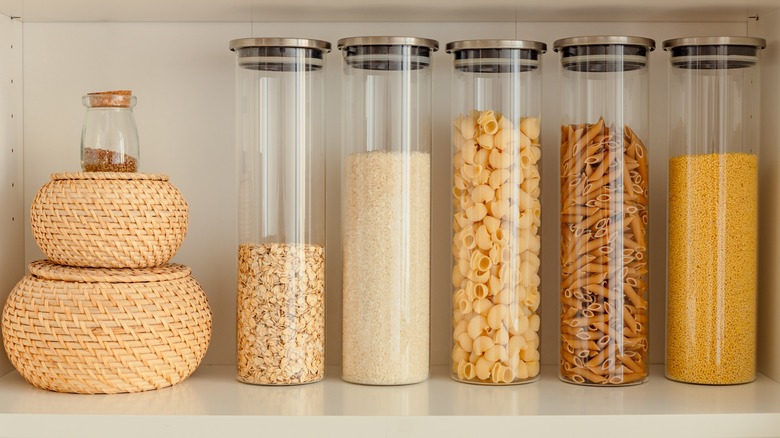33 Pantry Storage Hacks That Will Leave You With Maximum Space
We may receive a commission on purchases made from links.
The internet has been going crazy in recent years over content creators showing their organized bathrooms, bedrooms, and now kitchens. While watching the videos may not make you jump to clean out your dresser drawers or buy color-coded organizational systems to transform your life into something out of Marie Kondo's playbook, it may give you a fair amount of inspiration for how you can take simple steps to make your life a less cluttered place.
We're starting our organizational adventure with one of the most disorganized places in any home cook's space: the pantry. While there is a high return on keeping a meticulous space for all of your spices, dry goods, and cooking tools, the act of starting the reorganizing process of your pantry is no small feat. Here are some of the small and relatively inexpensive ways that you can transform your pantry to maximize its utility space.
1. Use tension rods to maximize storage space
Baking sheets and cutting boards are essentials for any cook, but storing them is a problem. If you want to maximize storage space in your pantry, you'll need a few tension rods. Install these rods vertically in your cabinets (one behind another) and store each sheet, pan, or tray in a slot. Rather than rifle through your stack to find the pan or cutting board you need, you can quickly grab your desired cooking tool and get cracking.
2. Add turntables to better utilize corners
Corners can be an annoying part of any pantry because food and tools can easily get lost or pushed out of view. As a result, you can lose a lot of potential space on your shelves. Instead, we recommend installing a turntable to maximize storage in the corners of your pantry. Invest in a turntable with a non-skid surface or a rim to prevent items from flying off when you spin it.
3. Use square-shaped containers
One of the reasons why people lose a lot of space in their pantries is simply because of the shape of their containers. Round containers take up a lot of space that is otherwise not used. Instead, you should use square containers for efficient pantry storage. That way, you can line up all of your containers in more compact rows and stack them on top of each other to maximize the vertical space of your pantry as well as the horizontal.
4. Only buy clear storage containers
If you constantly have to ask, "Wait, what is this again?" you may find yourself with a major storage no-no. If you're buying containers to decant your dry goods into or store dinner leftovers, always aim for clear containers. It pays to use clear containers for your pantry storage because it will save you a ton of time on labeling and allow you to grab items from your pantry when you need them quickly. Otherwise, you may find yourself rifling through jars and boxes and disrupting the careful balance of your space. Clear containers also allow you to see how much of an item you have, preventing you from buying too much and overfilling your pantry.
5. Streamline your purchases based on what you need
Before you go on your weekly grocery trip or start your meal plans, always be sure to shop your fridge and your pantry first. Doing so will allow you to only stock your essentials and avoid overstuffing your shelves, which is one of Geoffrey Zakarian's tips for organizing the perfect pantry. Shopping from your pantry also ensures that there is a rotation of items on your shelves, which will prevent stale or expired items from hanging around too long.
6. Keep older food toward the front
If you've worked in the restaurant industry, you've probably heard the acronym "FIFO" before. "First in, first out" means to always use the oldest items first before using the newer ones.
The rotation trick to ensure your food stays fresh starts when you purchase new items. Rather than placing these new items at the forefront of your pantry, put them in the back and pull older food toward the front. To ensure all of your older items get eaten, you can reserve a place in your pantry for "Eat me first" foods like opened bags of chips, cans expiring soon, and the like. It might even give you some ideas for meal planning.
7. Use the space above your stove to store infrequently used tools
Location matters when you store items in your kitchen and pantry. If you find a lot of your infrequently used appliances, like a food processor, immersion blender, and juicer, are taking up too much space in your pantry, try placing them on top of your oven or range. Although you shouldn't store food in the cabinet above the stove because many items are heat-sensitive, it is the perfect nook to store appliances that you may only use once every few months.
8. Have a special space dedicated to seasonal tools and foods
One of the reasons why your pantry is cluttered may be because you are keeping around items that you don't use or use infrequently. Take your holiday cookie cutters, pumpkin-spiced hot chocolate mix, and Valentine's Day sprinkles and store them in a dedicated basket in your kitchen. This will prevent your regular-use items from getting mixed up with others and will streamline your pantry organization process.
9. Buy a bag organizer to keep your storage bags in place
If you're anything like us, you know how hectic the bag drawer is. There are always bags falling out of the boxes, gallon freezer bags mixed in with the sandwich bags, and virtually no organization system to keep your drawers in order. Enter the bag organizer.
You can purchase a bag organizer from an online retailer and keep your bags neatly arranged from now on. The sleek design comes in many different finishes and materials to customize your kitchen.
10. Keep commonly used items at eye level
Grocery stores follow this same tactic when organizing their shelves. The most desirable products are always kept at eye level to encourage customers to buy more of them, while the cheaper and fringe brands are usually on the top and bottom.
Always keep items you use frequently at eye level when organizing your pantry. This will prevent you from pulling everything out to find the flour or pasta you use regularly. It will also help people (read: "spouses") unfamiliar with your pantry design find the items they need.
11. Store root vegetables in see-through baskets
See-through baskets are a lifesaver in your pantry because they allow for both proper ventilation and for you to be able to quickly take stock of items before going to the grocery store. We recommend storing your root vegetables, like potatoes, onions, and carrots, in wicker baskets. The baskets are much easier to organize than the oddly shaped bags you get from the grocery store.
It is equally important to be mindful of what items you place close together. For example, onions and potatoes should never be stored together because both release moisture as they age, which can cause mold, sprouts, and produce that you have to throw out.
12. Arrange items based on who uses them
If you live with children, you know how hectic snack time can be. Children in a pantry, picking and pushing through your neatly organized stacks of cans and grains to find a single snack-sized bag of Teddy Grahams is not ideal. Instead, you should design your kitchen with the people that use it in mind. For example, place all the kids' snacks in a place that is easy to reach and at their level. Store foods that you don't want your small children eating higher up in the pantry.
13. Turn to pants hangers to hang chip bags upright
If you have wire racks in your pantry, you're going to want to pay attention to this one. Instead of packing all of your opened chips into a big bin, use pants hangers to close the bags and hang them from the wire racks. This will save you a ton of space in the pantry and will prevent everyone in your home from forgetting about the already-opened bag of tortilla chips.
14. Shelf risers can increase storage space
One of the biggest mistakes people make when organizing their pantry is not utilizing the open space between shelves. With the help of a riser, you can easily store your spices and small cans. Risers come in many different shapes and sizes and can also allow you to stack items behind one another and read the labels more easily. You can also purchase an adjustable shelf to make room in small spaces that would otherwise go unused.
15. Repurpose jars for cheaper dry goods storage
If you're just starting your pantry organization journey, you don't have to rush out to get the fanciest and latest clear glass storage containers. Instead, you can repurpose some of your old containers and jars to design the pantry of your dreams. Be sure to save containers that have a similar shape, can be easily stacked, and have an accompanying lid.
One of the best ways to reduce waste in your home is to bring your clean glass jars to a bulk grocery store. You can calculate the tare weight of the empty jar, add your desired items, and walk out without wasting a plastic bag or a paper box.
16. Keep similar items together
One of the most systematic ways to organize your pantry for maximum space and ease of use is to group related products or ingredients into zones. Create a special section for baking where you can store your flour, sugars, leavening agents, and the like, as well as a space for all of your pasta shapes. When it comes time to collect your items from the pantry, you won't be rushing across the room to try to corral all of the tools and ingredients you need.
17. Line your shelves with a shower mat
If you place your pantry items right down on your shelves, you'll find items slipping, sliding, and moving around. Line the pantry with a sticky shower mat to keep your stacks of cans and jams orderly and protected. You can purchase one of these mats for less than $10 from an online retailer, and it will save you a ton of time in organizing and re-organizing your space after you pull out a pantry drawer a little too hard.
18. Utilize a pegboard
Pegboards are a simple way to give some life to the liminal spaces in your pantry, like walls and doors. You can put up a pegboard from your local hardware store with a few simple tools and hang items that would otherwise be difficult to store, such as mugs, spatulas, and pans. When organizing this part of your pantry, always be sure to properly mount all of the hardware and ensure that you are abiding by the maximum weight on the board.
19. Schedule a time to clean and assess your pantry
You've probably walked into your pantry before and cringed at how disorganized it is. Rather than cope with the enormous task of reorganizing your pantry all at once, try to break the project down into small, simple steps that you can do every week to tidy and keep your pantry organized. Make a checklist and include small tasks like wiping down the shelves, checking for expiration dates, and adding to your restock list.
20. Stay on top of expiration dates
One of the reasons why pantries get so cluttered is because items are accumulating that either have little utility in the kitchen or are past their prime. When organizing your pantry, take account of expiration dates — especially on items you decide to decant and place in a separate container. When you get new items like cans and jars, sort them in the pantry based on the expiration date.
21. Keep bins handy
Bins, bins, bins — an organizer's best friend! You can get deep bins and boxes from your local dollar store or online retailer to help keep deep cabinets in control. Place similar items in your bins and label them appropriately to make finding what you need easy. You should also stock your bins methodically and try to stack upwards, with similar items on top of one another, to maximize the diversity of items you put in the bin.
22. Consider your doors valuable real estate
Doors are an under-utilized space within walk-in pantries. You can add a pegboard or hanging bins on the door, but we recommend an even more straightforward hack: a shoe organizer. A clear shoe organizer easily affixes to the back of your door and provides valuable space for storing cans, jars, spices, and packets of food that would otherwise get lost in the confines of your pantry. As with all storage tools, be mindful of the weight restriction on the brackets to avoid an even bigger mess.
23. Avoid decanting all of your pantry items
One of the major pressures when it comes to organization is to decant everything — meaning to move everything from its original packaging to a separate container. Although it is aesthetically pleasing and worthy of a restocking video on TikTok, there are some items you just shouldn't decant. You should avoid decanting snack foods like chips and cookies because if your containers aren't perfectly airtight, the food will go stale very quickly. You should also avoid decanting items that exceed your allotted storage capacity, such as trying to pour 5 pounds of flour into a 3-pound container. This leaves you with two separate supplies of flour — which will inevitably take up more space in your cabinets. Removing the unnecessary outermost packaging of the products you purchase will save you plenty of bulk space.
24. Utilize rolling plant stands for appliances
Anyone who has had to carry a blender or bulky food processor across their kitchen knows how tedious large appliances can be. A rolling cart or a plant stand is the secret to your appliance woes. You can store your most commonly used appliances on the shelf and roll the entire thing out to wherever you're cooking. This will reduce the cabinet space that your large appliances take up and allow you to be a bit more mobile when working in your kitchen.
25. Store boxes with the skinny side facing out
Your pantry isn't a grocery store, so you don't need to advertise the labels of your products. Instead of storing your boxes with the wide side on display, store all of your packages with the short side facing outward; there's likely a tiny label that will tell you what's in the box. This tip will save you more horizontal space in your pantry and allow you to utilize the underused space deep in your cabinets.
26. Place a shower cap over infrequently used items
Shower caps are more useful than you'd think. You can use these handy, inexpensive bathroom essentials to cover items in your pantry that you don't often use. That fancy salad bowl that you only use for one summer barbecue a year? Covered. The wide-mouth wine chiller that you got for Christmas but have neglected to use? Check. When you get around to using these items, they will be dust-free and ready to use without needing a wash.
27. Store sticky items on a plate
Pantry goods can leak or leave behind residues that are difficult to clean. The easiest way to prevent a honey mess in your pantry, among other sticky situations, is to place a rimmed plate underneath the jar. When you notice things start to get gunky, you'll just need to clean the plate off rather than the entire shelf. You can also add a sticky liner to the bottom of your pantry that you can remove and wash regularly.
28. Use Instagram and Pinterest as inspiration, not be-all and end-alls
One of the mistakes many first-time organizers make is to go on social media platforms like Pinterest, Instagram, and TikTok to try and find organization ideas and tutorials. Not only will you be bombarded by information and tips that are impractical for most amateur organizers, but you'll likely just close the app feeling like you won't be able to accomplish the same level of organization as people with custom-built, professionally designed spaces. Instead, use social media as a way to look for small ideas and hacks that can make a difference in the space that you have.
29. Reuse soda boxes as can organizers
Don't rush to throw away those Coca-Cola 12-pack boxes. If you make a hole in the designated space of the box, you can recycle it as a tool to stack cans. Refill the boxes when your cans get low and you'll have an easy, free storage option.
If you're not a soda drinker, you can also store cans in soda can dispensers. These plastic organizers make it easy to see when your stock is getting low and can be stacked on top of one another in your pantry.
30. Employ a file organizer or magazine holder for boxes
You'll need to take a trip to the office supply store for this one. You can purchase magazine holders to help keep boxes upright in your pantry. Secure the holders to the cabinet doors in your pantry and use them as a place to store oddly shaped items like rolls of parchment paper and aluminum foil. While you're at the store, pick up a few file organizer racks to stack your thin boxes of linguini pasta in.
31. Recycle egg cartons into K-cup organizers
Almost every house has a few spare egg cartons lying around. Put these cartons to good use to wrangle all the leftover K-cups that are filling your drawers and coffee stations. You can make a variety carton with a medley of these K-cups, or use several egg cartons to separate flavors and varieties. The best part is that you can even paint and design your own custom K-cup holder.
32. Label things liberally
One of the most crucial tips for using small pull-out cabinets or containers without visible front labels is to always label the top of the item. That way, when you need to grab a spice from the cabinet, you can just pick out the one labeled "cinnamon" without having to rifle through several layers of jars.
Keep the staple ingredient jars — like flour, sugar, and salt — labeled, and use erasable labels for jars with items you don't always have in stock. You can also use your labels to write expiration dates or preparation instructions, such as the ratio of water to quinoa.
33. Install skinny shelves for small items
If you are designing a pantry from scratch, you may wonder what size shelving to choose. You can utilize your wall space by mounting skinny shelves to keep track of small items like spice jars that would otherwise get lost among bigger things. Add these free-standing shelves to your wall to create a small spice rack; we recommend installing it near your cooking space so that you can quickly grab spices as you're cooking.
